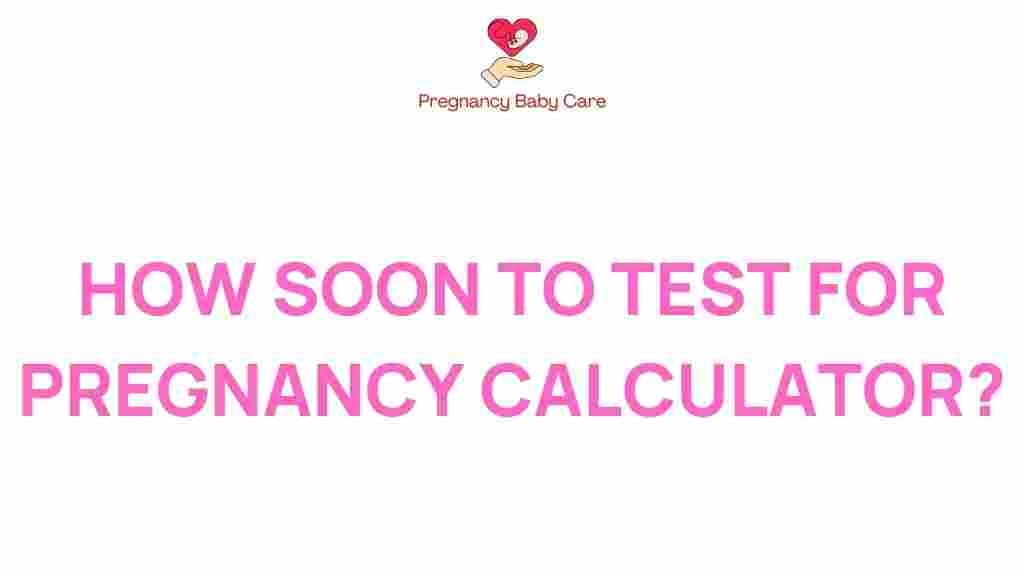How Soon Can You Use a Pregnancy Calculator Effectively?
Understanding your menstrual cycle, ovulation, and conception are vital aspects of family planning and reproductive health. A pregnancy calculator is a useful tool for anyone looking to conceive or track their pregnancy. But how soon can you use a pregnancy calculator effectively? In this article, we’ll discuss the best practices for utilizing a pregnancy calculator, the importance of early detection, and tips for maximizing your fertility awareness.
What is a Pregnancy Calculator?
A pregnancy calculator is an online tool or mobile application designed to help individuals estimate their due date, ovulation period, and fertile window. By inputting key information such as the first day of your last menstrual period (LMP) or the date of conception, the calculator can provide insights into your pregnancy timeline.
Understanding the Menstrual Cycle
To effectively use a pregnancy calculator, it’s essential to understand your menstrual cycle. The menstrual cycle typically lasts between 21 to 35 days and consists of several phases:
- Menstrual Phase: This phase starts with menstruation and lasts about 3-7 days.
- Follicular Phase: This phase begins on the first day of your period and ends with ovulation.
- Ovulation Phase: Ovulation typically occurs around the midpoint of your cycle, when an egg is released.
- Luteal Phase: This phase follows ovulation and lasts until the start of your next period.
Understanding these phases can help you track your ovulation and use a pregnancy calculator effectively.
When to Start Using a Pregnancy Calculator
You can start using a pregnancy calculator as soon as you have a regular menstrual cycle. Here’s a step-by-step guide on how to use it effectively:
- Track Your Menstrual Cycle: Keep a record of your menstrual cycles for at least three months. Note the length of each cycle and the start and end dates of your period.
- Identify Your Ovulation Window: Use an ovulation tracker to determine when you are most fertile. This typically occurs 12-16 days before your next expected period.
- Input Data into the Calculator: Enter the first day of your last menstrual period and the average length of your cycle into the pregnancy calculator.
- Review the Results: The calculator will provide you with your estimated due date and fertile window, which can help with conception timing.
Early Detection of Pregnancy
Using a pregnancy calculator is most effective when combined with early detection methods. A pregnancy test can confirm pregnancy, typically after a missed period. Here are some tips for early detection:
- Take a Home Pregnancy Test: Use a test that detects the hormone hCG, which is produced during pregnancy. For best results, wait until after your missed period.
- Observe Early Symptoms: Look for early pregnancy symptoms such as missed periods, breast tenderness, nausea, and fatigue.
- Consult Your Healthcare Provider: If you suspect you are pregnant, schedule an appointment for a blood test or ultrasound.
Maximizing Your Fertility Awareness
Fertility awareness is crucial for those trying to conceive. Here are some health tips to enhance your fertility awareness:
- Maintain a Healthy Diet: A balanced diet rich in fruits, vegetables, whole grains, and lean proteins can support reproductive health.
- Stay Hydrated: Drinking plenty of water is essential for overall health and can aid in the fertility process.
- Exercise Regularly: Moderate exercise can help maintain a healthy weight, which is important for fertility.
- Manage Stress: High-stress levels can affect your menstrual cycle and ovulation. Consider relaxation techniques such as yoga or meditation.
Troubleshooting Common Issues
Sometimes, using a pregnancy calculator might not yield expected results. Here are some troubleshooting tips:
- Irregular Menstrual Cycles: If your cycles are irregular, it might be challenging to predict ovulation accurately. Consider using an ovulation tracker or consulting with a healthcare professional.
- Incorrect Data Entry: Ensure that you accurately input the correct dates and cycle lengths into the calculator.
- Delayed Ovulation: Factors such as stress, illness, or changes in weight can delay ovulation. Track your symptoms closely to identify any changes.
Conclusion
Using a pregnancy calculator can be an effective way to understand your menstrual cycle, track ovulation, and plan for conception. By starting to use a calculator as soon as you have a regular cycle and combining it with early detection methods, you can maximize your chances of pregnancy. Remember to focus on your overall health and fertility awareness, and don’t hesitate to consult professionals when needed.
For more information on tracking your fertility and using a pregnancy calculator, check out this comprehensive guide. And for the latest research on women’s health, visit this resource.
This article is in the category Pregnancy and created by PregnancyBabyCare Team
